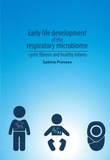Early life development of the respiratory microbiome
cystic fibrosis and healthy infants
Summary
Background
Negative and positive associations between bacterial species have been described in the respiratory tract. Vaccination is a modifier of these interactions. Although appreciable levels of success have been achieved with current pneumococcal conjugate vaccines, there is a need for alternative pneumococcal serotype-independent protection strategies.
Over the past decades, most of CF research focused on respiratory end-stage lung disease. However, the origins and initiating factors in CF lung disease might determine the progression, severity, and disease burden later in life. Understanding the origins, quantifying the initial defects, and intervening early could make a long-term difference for people with Cystic Fibrosis disease.
Methods
We studied the immunogenicity of virulence proteins of S. pneumoniae and S. aureus. We also describe the long-term impact of the current pneumococcal conjugate vaccines (PCV7) on bacterial colonization with other potential pathogens that are living in a complex interaction with S. pneumoniae and the host.
Furthermore we characterized respiratory microbiota community composition of 20 young cystic fibrosis (CF) patients and 45 healthy controls, by culture-dependent and novel culture independent techniques in the nasopharynx (NP), oropharynx (OP) and lower respiratory tract.
Results
We observed that colonization with S. pneumoniae and S. aureus leads to natural immunity against many proteins, predominantly proteins with immune-modulating functions, irrespective of PCV7 vaccination. None of the antibodies, however, appeared to be protective against new acquisition of either pathogen, possibly due to the polymorphic nature of those proteins.
Furthermore we detected 3 and 4.5 years after PCV7 implementation in the NIP in the Netherlands higher carriage rates of S. aureus and H. influenzae among 11-month-old children and their parents.
We determined that directly from birth on, the development of nasopharyngeal microbial colonization profiles including the commensal flora is different in CF infants compared to controls. Additionally, already the first antibiotic (AB) courses and prophylaxis early in life alter the respiratory microbiota, with a significant reduction in potential beneficial commensals and a significant increase in potentially pathogenic gram-negative bacteria although fortunately still in low abundance. With respect to microbial diagnostics in CF infants, OP microbiota profiles resemble lung microbiota more closely than NP microbiota for commensals but not for clinical important potential respiratory pathogens, which were most commonly detected in NP samples.
Conclusions
Our data underline that the optimal composition of a protein vaccine needs to be multi-component, that the candidate protein antigens should be surface exposed and that these proteins should be expressed by the majority of clinical isolates belonging to diverse lineages.
Higher carriage rates of S. aureus and H. influenzae may have implications for (respiratory) disease incidence caused by these bacteria in the PCV7 vaccinated childhood population.
Further, large, long-term, and placebo-controlled studies are required to prove the potential negative side-effects of diverse types of AB-prophylaxis in infants with CF. Finally, our data suggest that the lungs of infants with CF may have their own independent functional ecosystem that seems seeded by, but is not identical to, the URT ecosystem.
